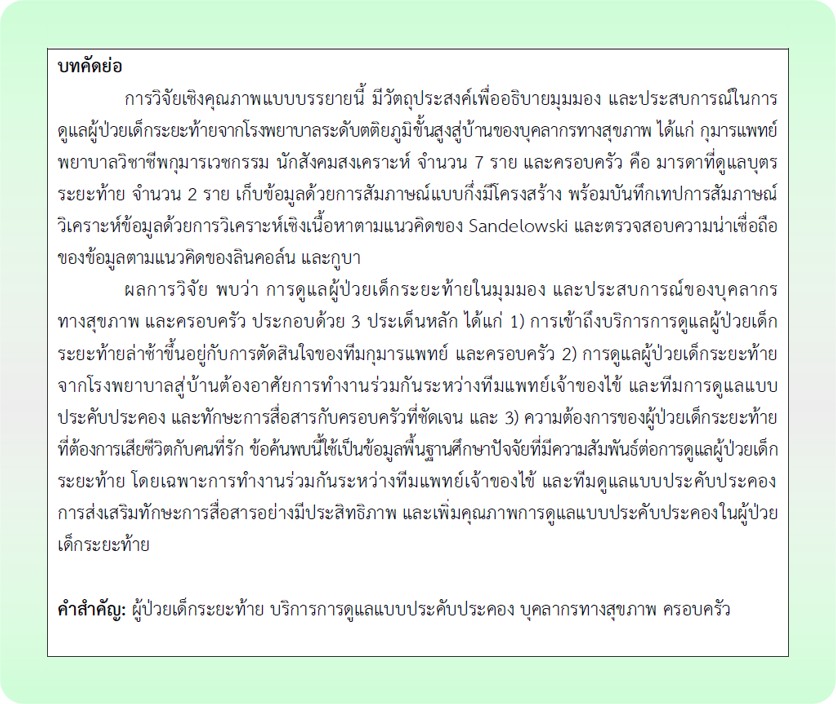End-of-Life Care of Pediatric Patients from the Super Tertiary Care Hospital to Home: Perspectives and Experiences of Health Care Providers and Family
Main Article Content
Abstract
This qualitative descriptive research aimed to describe perspectives and experiences of the end-of-life care from the super tertiary hospital to home in 7 healthcare providers consisting of pediatricians, pediatric nurses, social workers and 2 mothers who take care children at end-of-life. Data were collected by semi-structured interviews and audio record. Sandelowski’s qualitative content analysis method was employed for data analysis by Lincoln and Guba’s criteria in their approach to trustworthiness.
The results revealed that end-of-life care as perceived and experienced by healthcare providers and families could be divided into 3 themes were 1) delayed access to end-of-life care for children depends on decisions made by the pediatrician team and family 2) caring for end-of-life pediatric patients from the hospital to their homes requires collaboration between the pediatric team and the palliative care team and clear communication skills with families and 3) needs of terminally ill pediatric patients who want to die with their loved ones. The findings can be basic information for studying factors related to end-of-life pediatric care. Especially the collaboration between the primary care team and the palliative care team, promoting effective communication skills and enhance the efficiency of palliative care for terminally ill pediatric patients.
Article Details

This work is licensed under a Creative Commons Attribution-NonCommercial-NoDerivatives 4.0 International License.
References
Snaman J, McCarthy S, Wiener L, Wolfe J. Pediatric palliative care in oncology. Journal of Clinical Oncology 2020;38(9):954-62. doi: 10.1200/JCO.18.02331.
Amarri S, Ottaviani A, Campagna A, Panfilis DL. Children with medical complexity and paediatric palliative care: a retrospective cross-sectional survey of prevalence and needs. Italian Journal of Pediatrics 2021;47(1):110. doi: 10.1186/s13052-021-01059-8.
Brock KE, Allen KE, Falk E, Velozzi-Averhoff C, DeGroote NP, Klick J, et al. Association of a pediatric palliative oncology clinic on palliative care access, timing and location of care for children with cancer. Supportive Care in Cancer: Official Journal of the Multinational Association of Supportive Care in Cancer 2021;29(4):1849-57. doi: 10.1007/s00520-020-05671-y.
Chen SH, Wu ET, Wang CC, Su MY, Chang CH, Chen HL, et al. Increasing trend and effects of pediatric palliative care on children with noncancer diagnosis. Journal of Pain and Symptom Manage 2023;66(3):230-7. doi: 10.1016/j.jpainsymman.2023.05.018.
Pairojkul S, Thongkhamcharoen R, Raksasataya A, Sorasit C, Nakawiro P, Sudsa S, et al. Integration of specialist palliative care into tertiary hospitals: a multicenter point prevalence survey from Thailand 2021. Palliative Medicine Reports 2021;2(1):272-9. doi: 10.1089/pmr.2021.0003.
Sriratanaban J, Chatkaew P, Srirattanaball P, Ngamkiatpaisarn S, Manatwanich P, Rattananupong T, et al. Guideline for developing hospice care in Thailand: care options for the quality of life of terminally ill patients. Bangkok: health systems research institute; 2018. Research center for health service system development, and Faculty of Medicine Chulalongkorn University and the academic service center of Chulalongkorn university [Internet]. 2018 [cited 2021 Nov 20]. Available from: http://digital.nlt.go.th/dlib/files/original/1015a0a538f38d04f3e8114a02fdb943.pdf (in Thai)
Ministry of Public Health. Service plan and key performance indicator [Internet]. 2024 [cited 2022 Oct 25]. Available from: spd.moph.go.th/wp-content/uploads/2023/11/KPI_template_672.pdf (in Thai)
Thamanee G, Patoomwan A, Phengjard J. Palliative care needs of children with cancer and their families as perceived by family caregivers. Ramathibodi Nursing Journal 2018;24(3):295-312. (in Thai)
Sandelowski M. Whatever happened to qualitative description?. Research in Nursing and Health 2000;23(4):334-40. doi: 10.1002/1098-240x(200008)23:4<334::aid-nur9>3.0.co;2-g.
Lincoln YS, Guba EG. Naturalistic inquiry. Newbury Park: Sage; 1985.
Sukcharoen P. Nursing service system for palliative care in tertiary hospitals [Dissertation]. Bangkok: Chulalongkorn University; 2013. (in Thai)
Mcneil MJ, Godfrey A, Loggetto P, Oliveira Junior AD, Job G, Boldrini E, et al. Physician perceptions of and barriers to pediatric palliative care for children with cancer in Brazil. JCO Global Oncology 2023;9:e2300057. doi: 10.1200/GO.23.00057.
Pyke-Grimm KA, Fisher B, Haskamp A, Bell CJ, Newman A. Providing palliative and hospice care to children, adolescents and young adults with cancer. Seminars in Oncology Nursing 2021;37(3):151166. doi: 10.1016/j.soncn.2021.151166.
Watch V, Anga G, Kilalang C, Pulsan F, Vince JD, Duke T. Children with palliative care needs in Papua New Guinea, and perspectives from their parents and health care workers: a qualitative study. BioMed Central Palliative Care 2023;22(1):68. doi: 10.1186/s12904-023-01177-6.
Garcia-Quintero X, Cleves D, Cuervo MI, Mcneil M, Salek M, Robertson EG, et al. Communication of early integration of palliative care for children with cancer in Latin America: the care as a vessel metaphor. Journal of Global Oncology 2023;9:e2200281. doi: 10.1200/GO.22.00281.
Songtantarax P, Siripoon P, Ponyiem P, Chuson K, Jampakaem P, Suwannalao J. The role of nurses in palliative care for pediatric cancer patients and families: a case study of Neuroblastoma on the recurrent period. Journal of Nursing Science and Health 2022;45(2):20-30. (in Thai)
Papworth A, Hackett J, Beresford B, Murtagh F, Weatherly H, Hinde S, et al. Regional perspectives on the coordination and delivery of paediatric end-of-life care in the UK: a qualitative study. BioMed Central Palliative Care 2023;22(1):117. doi: 10.1186/s12904-023-01238-w.
Carr K, Hasson F, McIlfatrick S, Downing J. Factors associated with health professional’s decision to initiate paediatric advance care planning: a systematic integrative review. Palliative Medicine 2021;35(3):503-28. doi: 10.1177/0269216320983197.
Michel C, Seipp H, Kuss K, Hach M, Kussin A, Riera-Knorrenschild J, et al. Key aspects of psychosocial needs in palliative care - a qualitative analysis within the setting of a palliative care unit in comparison with specialized palliative home care. BMC Palliative Care 2023;22(1):100. doi: 10.1186/s12904-02301227-z.
Rico-Mena P, Güeita-Rodríguez J, Martino-Alba R, Chocarro-Gonzalez L, Sanz-Esteban I, Palacios-Ceña D. Understanding pediatric palliative care within interdisciplinary palliative programs: a qualitative study. BMC Palliative Care 2023;22(1):80. doi: 10.1186/s12904-023-01194-5.
Dokmai P, Meemon N, Paek SC, Tayjasanant S. Structure and process of palliative care provision: a nationwide study of public hospitals in Thailand. BioMed Central Health Services Research 2021;21(1):616. doi: 10.1186/s12913-021-06623-w.
Napnian R. The effects of palliative care in spiritual aspect. Nakhonphanom Hospital Journal 2021;8(2):65-77. (in Thai)
Mitchell S, Spry JL, Hill E, Coad J, Dale J, Plunkett A. Parental experiences of end of life care decision making for children with life-limiting conditions in the paediatric intensive care unit: a qualitative interview study. British Medical Journal Open 2019;9(5):e028548. doi: 10.1136/bmjopen-2018-028548.

